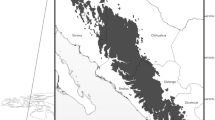Abstract
In the present paper we identify biodiversity hotspots of endemic terrestrial invertebrates in southern Greece, using four different criteria and five taxonomic groups. The hotspots identification procedure was facilitated by the use of the MapInfoPro G.I.S. software. We mapped the known distribution of 424 endemic species on a digital map of southern Greece in 548 10 × 10 km2 grids. The total number of registrations (records per grid) is 3826 in 465 grids. Registrations are unevenly distributed in the five sub-regions of the study area, a fact that results from both the unequal collecting effort applied in each sub-region and their different levels of endemism. We first identified the hotspots for each individual taxonomic group, and then for the total species pool. Finally, we analyzed the species saturation pattern in order to find the minimum number of grids needed for the inclusion of 85% of the total number of species. The most important hotspots are mostly at the higher mountains of the study area, especially on Taygetos and Idi Mts. We also give a brief evaluation of the performance of the four criteria used in the case of endemic species analyses.
Similar content being viewed by others
References
Collins NM andWells SM (1987) Invertebrates in Need of Special Protection in Europe. Council of Europe, Nature and Environment, No. 35
Council Directive 92/43/EEC of 21 May 1992 on the conservation of natural habitats and of wild fauna and flora
Council of Europe (1979) Convention on the Conservation of European Wildlife and Natural Habitats. Bern, 19.IX.1979
Dafis S,Papastergiadou E,Georghiou K,Babalonas D,Georgiadis T,Papageorgiou M,Lazaridou T andTsiaoussi V (1996) Directive 92/43/EEC. The Greek ‘Habitat’ Project NATURA 2000: An Overview. Life Contract B4-3200/84/756, Commission of the European Communities DG XI, The Goulandris Natural History Museum-Greek Biotope/Wetland Centre. University of Athens, Aristotle University of Thessaloniki, University of Patras, 917 pp
Economic Commission for Europe (1991) European Red List of Globally Threatened Animals and Plants. United Nations, 150 pp
Gaston K (1996) Biodiversity congruence. Progress in Physical Geography 20: 105-112
Griffin PC (1999) Endangered species ‘hot spots’ in Russia and centers of endemism. Biodiversity and Conservation 8: 497-511
Hansson L (1998) Local hot spots and their edge effects: small mammals in oak-hazel woodland. Oikos 81: 55-62
IUCN (1994) 1994 IUCN Red List of Threatened Animals. IUCN, Gland, Switzerland/Cambridge, UK Koomen P and van Helsdingen PJ (1993) Listing of Biotopes in Europe According to Their Significance for Invertebrates. Nature and Environment, No 77, Council of Europe
Legakis A (1990) The status of the Bern invertebrates in Greece. In: Colloquy on the Bern Convention, Invertebrates and Their Conservation, pp 17-19. No 10. Council of Europe, Environmental Encounters Series
Meliadou A andTroumbis AY (1997) Aspects of heterogeneity in the distribution of diversity of the European Herpetofauna. Acta Oecologica 18: 393-412
Myers N (1990) The biodiversity challenge: Expanded hotspots analysis. The Environmentalist 10(4): 243-256
Myers N,Mittermeier RA,Mittermeier CG,da Fonseca GAB andKent J (2000) Biodiversity hotspots for conservation priorities. Nature 403: 853-858
Mylonas M (1981) The zoogeography and ecology of the terrestrial molluscs of cyclades. PhD thesis, University of Athens, Athens [in Greek]
Prendegast JR,Quinn RM,Lawton JH,Eversham BC andGibbons DW (1993) Rare species, the coincidence of diversity hotspots and conservation strategies. Nature 365: 335-337
Sfenthourakis S (1994) Biogeography, systematics and ecological aspects of terrestrial isopods in central Aegean islands. PhD thesis, University of Athens, Athens [in Greek]
Sfenthourakis S (1996) A biogeographic analysis of terrestrial isopods (Isopoda, Oniscidea) from central Aegean islands (Greece). Journal of Biogeography 23: 687-698
Sfenthourakis S andGiokas S (1998) An analysis of Greek oniscidean endemism. Israel Journal of Zoology 44: 273-282
Trichas A (1996) Ecology and biogeography of the ground coleoptera in the south Aegean area. PhD thesis, University of Crete, Irakleion [in Greek]
Troumbis AY andDimitrakopoulos PG (1998) Geographic coincidence of diversity threatspots for three taxa and conservation planning in Greece. Biological Conservation 84: 1-6
Vardinoyianni K (1994) Biogeography of land snails in the south Aegean island arc. PhD thesis, University of Athens, Athens [ in Greek]
Author information
Authors and Affiliations
Rights and permissions
About this article
Cite this article
Sfenthourakis, S., Legakis, A. Hotspots of endemic terrestrial invertebrates in southern Greece. Biodiversity and Conservation 10, 1387–1417 (2001). https://doi.org/10.1023/A:1016672415953
Issue Date:
DOI: https://doi.org/10.1023/A:1016672415953




